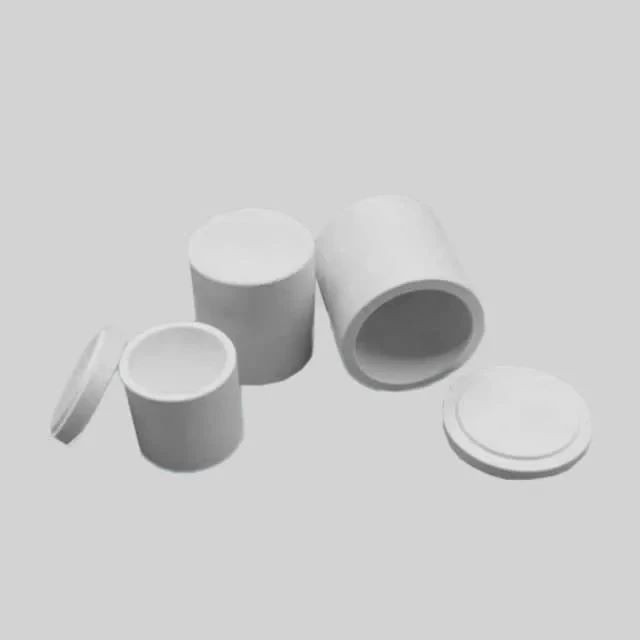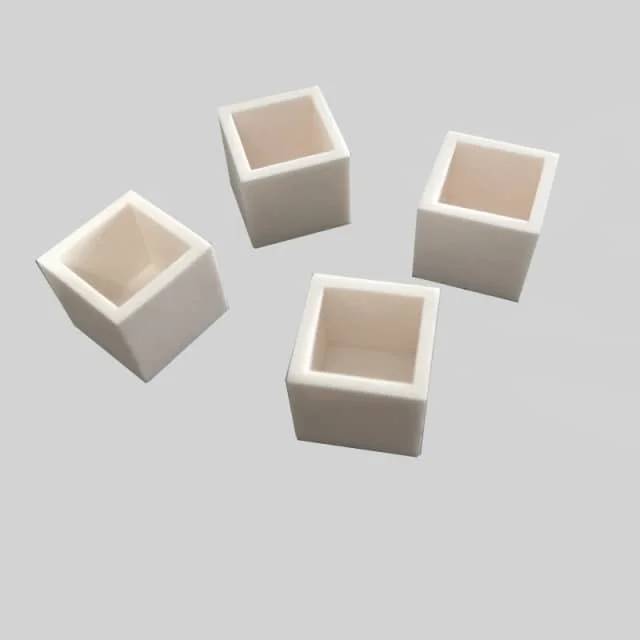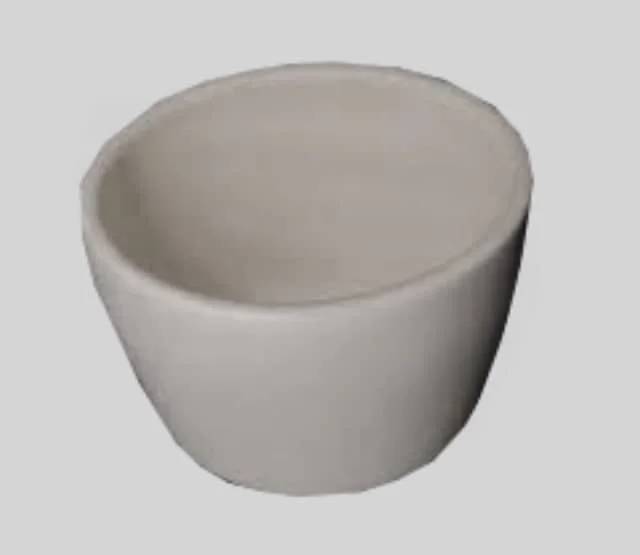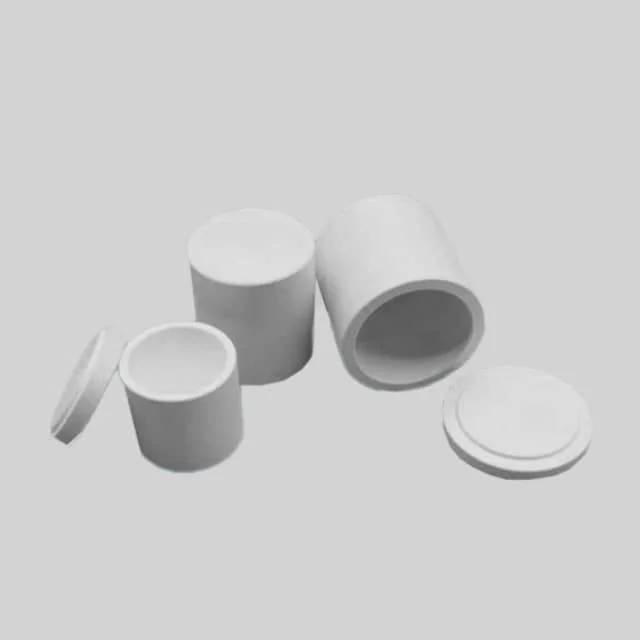
Thin Film Deposition Parts
Evaporation Crucible for Organic Matter
Item Number : KME-YJG
Price varies based on specs and customizations
- Material
- Quartz crucible / Alumina crucible / Boron nitride crucible /
- crucible size
- 13*13mm / 18*20mm / 25.4*30mm / 25.4*30mm / 10*25mm
Shipping:
Contact us to get shipping details Enjoy On-time Dispatch Guarantee.
Why Choose Us
Reliable PartnerEasy ordering process, quality products, and dedicated support for your business success.
Application
The Evaporation crucible for organic matter is a special container used in the laboratory to control the evaporation of organic solvents. They have a wide and shallow design to maximize the heating surface area and allow for efficient solvent evaporation. These crucibles are commonly used for concentration, solvent removal and preparation of solid residues in various laboratory procedures. They are especially suitable for handling volatile organic compounds (VOCs) which evaporate easily at lower temperatures.
Detail & Parts






Technical specifications
| crucible size | 13*13mm / 18*20mm / 25.4*30mm / 25.4*30mm / 10*25mm |
The crucibles we show are available in different sizes and custom sizes are available on request.
Explanation of proper nouns
- Thin Film Deposition: Evaporation crucible for organic matter play a vital role in thin film deposition techniques such as thermal evaporation or organic vapor deposition. By heating the crucible and allowing the material to evaporate, a thin film is deposited onto the substrate.
- Sample Preparation: Evaporation crucible for organic matter are used to dry and concentrate solutions or suspensions of organic compounds, allowing the solvent to evaporate and leaving the desired solid residue.
- Solvent Evaporation: Evaporation crucible for organic matter are used to remove solvents from solutions or mixtures by gentle heating.
- Crystallization: Evaporation crucibles are used in the crystallization process. By slow evaporation of the solvent, a crystalline solid can form in the crucible.
- Concentration and volume reduction: Evaporation crucibles are used to concentrate solutions or reduce the volume of liquid samples.
- Precursor Synthesis: Evaporation crucible for organic matter are used for the synthesis of various organic and inorganic materials. They can be used to evaporate and heat precursor solutions to obtain desired compounds or materials.
Advantage
- Heat resistance: It can withstand high temperature without deformation or melting.
- Chemical resistance: inert and resistant to most organic solvents, preventing interaction or contamination.
- Versatility: Compatible with various organic solvents.
- Various sizes and shapes: Provide different sizes and shapes to meet the needs of experiments.
- Sample Concentration: Facilitates sample concentration by removing solvent.
- Easy to monitor: the shallow design can visually observe the evaporation process.
- Cost-effective: Relatively cheap compared with other laboratory equipment.
Precautions
- The heated crucible cannot be quenched, and it should be removed with a crucible clamp.
- Heat the crucible on the clay triangle.
- Before use, gradually heat the crucible to 500 degrees Celsius, and store it in a dry place after use.
- Choose an appropriate amount of raw materials to fill the crucible, avoid overfilling to prevent cracks caused by thermal expansion.
- Whenever possible, use a spoon rather than a caliper when removing molten metal. If calipers are used, make sure they conform to the shape of the crucible and apply minimal localized force to avoid shortening the life of the crucible.
- Avoid spraying strong oxidizing flame directly on the crucible, which will oxidize the crucible material and reduce its service life.
FAQ
The Difference Between Metal Crucible And Ceramic Crucible.
What Are The Common Materials Used For Evaporating Crucibles?
What Are The Advantages Of Using Evaporating Crucibles?
How Should Evaporating Crucibles Be Handled And Maintained?
4.8
out of
5
These crucibles are a lifesaver for our lab! They're perfect for evaporating solvents and concentrating samples.
4.9
out of
5
I've been using these crucibles for a few months now and I'm really impressed with their quality. They're very durable and easy to clean.
4.7
out of
5
These crucibles are a great value for the price. They're made of high-quality materials and they've held up well to heavy use.
4.8
out of
5
I was hesitant to buy these crucibles at first because they were a bit more expensive than the ones I usually use, but I'm glad I did. They're definitely worth the extra money.
5.0
out of
5
These crucibles are the best I've ever used. They're so easy to use and they produce great results. I highly recommend them to anyone who works in a lab.
4.9
out of
5
I've been using these crucibles for a few years now and I've never had any problems with them. They're very reliable and they always produce consistent results.
4.7
out of
5
These crucibles are a great addition to my lab. They're very versatile and I can use them for a variety of different applications.
4.8
out of
5
I'm really happy with these crucibles. They're made of high-quality materials and they're very durable. I've been using them for a few months now and they're still in great condition.
4.9
out of
5
These crucibles are a great value for the price. They're made of high-quality materials and they've held up well to heavy use. I would definitely recommend them to anyone who works in a lab.
5.0
out of
5
These crucibles are the best I've ever used. They're so easy to use and they produce great results. I highly recommend them to anyone who works in a lab.
4.9
out of
5
I've been using these crucibles for a few years now and I've never had any problems with them. They're very reliable and they always produce consistent results.
4.7
out of
5
These crucibles are a great addition to my lab. They're very versatile and I can use them for a variety of different applications.
4.8
out of
5
I'm really happy with these crucibles. They're made of high-quality materials and they're very durable. I've been using them for a few months now and they're still in great condition.
4.9
out of
5
These crucibles are a great value for the price. They're made of high-quality materials and they've held up well to heavy use. I would definitely recommend them to anyone who works in a lab.
REQUEST A QUOTE
Our professional team will reply to you within one business day. Please feel free to contact us!
Related Products

Evaporation Boat for Organic Matter
The evaporation boat for organic matter is an important tool for precise and uniform heating during the deposition of organic materials.

High Purity Pure Graphite Crucible for Evaporation
Vessels for high temperature applications, where materials are kept at extremely high temperatures to evaporate, allowing thin films to be deposited on substrates.

E Beam Crucibles Electron Gun Beam Crucible for Evaporation
In the context of electron gun beam evaporation, a crucible is a container or source holder used to contain and evaporate the material to be deposited onto a substrate.

Electron Beam Evaporation Coating Gold Plating Tungsten Molybdenum Crucible for Evaporation
These crucibles act as containers for the gold material evaporated by the electron evaporation beam while precisely directing the electron beam for precise deposition.

Ceramic Evaporation Boat Set Alumina Crucible for Laboratory Use
It can be used for vapor deposition of various metals and alloys. Most metals can be evaporated completely without loss. Evaporation baskets are reusable.1

Electron Beam Evaporation Coating Conductive Boron Nitride Crucible BN Crucible
High-purity and smooth conductive boron nitride crucible for electron beam evaporation coating, with high temperature and thermal cycling performance.

Tungsten and molybdenum crucibles are commonly used in electron beam evaporation processes due to their excellent thermal and mechanical properties.

Electron Beam Evaporation Coating Oxygen-Free Copper Crucible and Evaporation Boat
Electron Beam Evaporation Coating Oxygen-Free Copper Crucible enables precise co-deposition of various materials. Its controlled temperature and water-cooled design ensure pure and efficient thin film deposition.

High Purity Pure Graphite Crucible for Electron Beam Evaporation
A technology mainly used in the field of power electronics. It is a graphite film made of carbon source material by material deposition using electron beam technology.

In the journey of scientific exploration and industrial production, every detail is crucial. Our arc-shaped alumina ceramic crucibles, with their excellent high temperature resistance and stable chemical properties, have become a powerful assistant in laboratories and industrial fields. They are made of high-purity alumina materials and manufactured through precision processes to ensure excellent performance in extreme environments.
Related Articles

How To Use A Rotary Evaporator
Rotary evaporators (also called "rotavaps") are used to remove solvents from reaction mixtures and can accommodate volumes as large as 3 liters.

Advantages of Using a Rotary Evaporator for Solvent Removal
Rotary evaporators are laboratory instruments used for solvent removal. They work by rotating a flask containing a liquid sample, which creates a thin film on the surface of the flask.

How to Use a Rotary Evaporator for Concentrating Samples
Rotary evaporators, also known as rotovaps, are laboratory devices used to remove solvents from liquid mixtures through evaporation.

A Beginner's Guide to Using a Rotary Evaporator
A rotary evaporator is a powerful and versatile tool for removing solvents from samples by evaporation.

What Is Rotary Evaporator Used For?
A rotary evaporator (or rotavap/rotovap) is a device used in chemical laboratories for the efficient and gentle removal of solvents from samples by evaporation.

How to Save Money When Buying a Rotary Evaporator (Rotavapor)
A rotary evaporator, also known as a rotavapor, is a laboratory equipment commonly used to remove solvents from a sample. It works by rotating the sample flask to create a thin film of the solvent, which is then evaporated.

How to Use a Rotary Evaporator Like a Pro
Rotary evaporators, also known as rotovaps, are commonly used in chemical labs for the efficient and gentle removal of solvents from samples by evaporation.

Mastering the Art of Rotary Evaporation
Rotary evaporation is a technique used in laboratories to remove solvents from samples through the process of evaporation.

Boost Your Efficiency Why A Rotary Evaporator Is Better
Rotary evaporation is a technique used to remove solvents from samples, typically with the use of a vacuum. This method is widely used in laboratories due to its efficiency, safety, and cost-effectiveness.

Exploring the Science Behind Rotary Evaporators: How They Work and Their Applications
Rotary evaporators, also known as rotovaps or rotating evaporators, are commonly used in labs to remove solvents from samples or to create concentrated solutions. These devices work by rotating a flask or sample container at a high speed while simultaneously heating and evaporating the solvent.

Expanding Possibilities with Rotavapor An Innovative Solution for Solvent Evaporation
Solvent evaporation is an essential process in many industries, including pharmaceuticals, food and beverage, and chemical manufacturing, among others.

How to Maximize Extraction Efficiency with a Rotary Evaporator
Rotary evaporation is a technique used to separate solvents from a sample through the removal of volatile components. It involves placing a sample in a round bottom flask and rotating it while under vacuum.